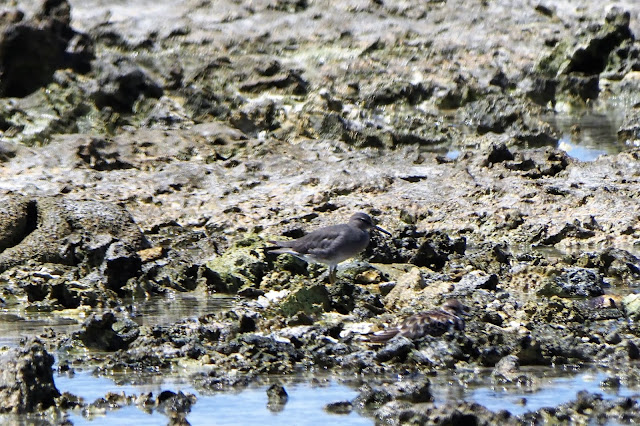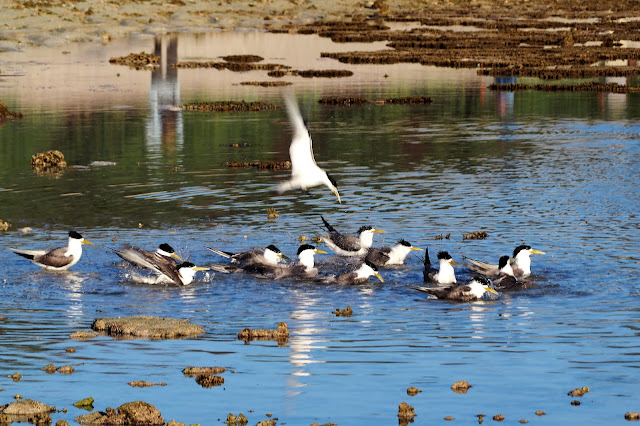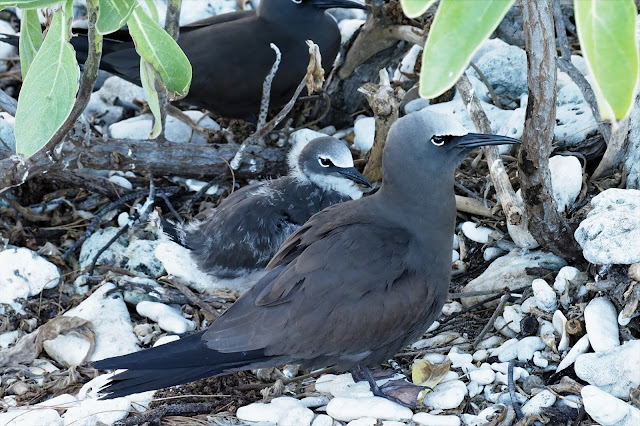Lady Elliot Island is the southern most coral cay of the Great Barrier Reef. It is only 45 hectares in area & can be reached by a 40 min chartered flight from Hervey bay, Bundaberg, Redcliffe & the Gold Coast. The Island was rehabilitated by lighthouse staff from 1966 as the island was desolate of trees as a result of mining for guano during 1864 - 1874. Pisonia grandis that had been naturally occurring prior to the guano mining was replanted. An eco resort & a runway for small aircraft to land on for visitors were built.
The small plane seated about 12 passengers.
The accommodation here are some of the Glamping Tents. They have have had a recent upgrade with solid walls & roof. Ours had bunk beds to sleep 4 people. Breakfast, dinner, snorkel gear & a glass bottom boat tour were included in the package. We were just 20 m from our amenities block. The glamping tents are on the budget end of accommodation styles, but this suited us very well. Thank you Julie for allowing me to use your photo here.
It was peak bird breeding season during the months of December & January, so 6 friends & I decided mid December would be a great time to visit. We are all bird watching enthusiasts.
This is my 2nd time visiting Lady Elliot Island (LEI) & the enthusiasm wasn't any less than the 1st visit 2 years earlier. 1 of our group is better at estimating bird numbers & his estimation was a staggering 72,300 birds from 6 of the 21 species of birds we saw on the Island. We had birds living& breeding next to our accommodation, in pisonia trees along the paths to our cabins, the rest of the island bushland, next to the runway & on the beach. They were literally everywhere. Birds that are normally shy on the mainland were not bothered with how close we were to them. They are just so used to having people in their habitat.
After landing & the island's introduction tour we were able to go hard with our 1st days activities. We had an 8am flight out to LEI, so had many hours of snorkelling & birding to squeeze in until sunset. We booked our all important Glass Bottom Boat tour for that afternoon, which included snorkelling the reef under the watchful eyes of our tour guides. As the tide was high & right for snorkelling we chose to snorkel the Lagoon area before lunch & just bird around the resort between those activities
This is the scene of the "Lagoon" at high tide - this area is a protected coral reef where we can snorkel more safely during high tide, although the waters current was a little brisk on the day that I snorkelled here. The depth is less than 3 m out to that breaking water line, teaming with different corals, fish & other marine life.
The western side of the island has a deeper coral reef that is more beautiful than the Lagoon on the eastern side. This is where we had our glass bottom boat tour & snorkelling. On our next 2 days we were able to swim out to the reef surrounding those buoys attached to ropes to give us safety when snorkelling.
Between our snorkelling outings we had time to walk around the resort area & part of the islands beaches to photograph some of the beautiful birds.
The Black Noddy's are the smaller of the 2 Noddy's on the Island. They were literally nesting everywhere & were estimated to be 50,000 of them. We saw Black Noddy chicks at various ages from egg to near fledging.
Always a delight to see with Frigatebirds hovering overhead. This was a female Great Frigatebird.
Sooty Oystercatcher seen when walking along the exposed rocky shelves
We also found a couple of Wandering Tattlers.
Crested Tern with his chick that had left it's nest but still reliant on parents for food taken from the fish laden waters near the island.
Black-naped Terns.
Comparison for size - Greater Crested Tern on the left & Black-naped Tern.
Roseate Tern flying back out to catch more fish for his chick.
Black-naped Tern chick was also near by.
Walking back to the resort along the runway & Common Noddy's were nesting in various places, some shaded, others in the more exposed areas to the sun like this 1. It's pretty hot.
Bridled Terns were the most common ground living bird around the resort.
More Frigatebirds overhead - this 1 being a juvenile Great Frigatebird.
Another Great Frigatebird.
Buff-banded Rails can be difficult to see in bush lands on the mainland, but on LEI they are almost under our feet, esp around the cafe area.
Pacific Golden Plover are 1 of the migratory shorebirds that are resident during the southern summer months.
Back on the beach were more Roseate Tern, this pair with their chick.
Common Noddy's making a nest sitting shift change over.
Bridled Tern parent feeding his very young chick small bits of food.
More Buff-banded Rails - there were probably up to 200 of them on LEI.
After the sun goes down Wedge-tailed Shearwaters come into roost around the island. Last time we stayed in 2018 they were under our Safari Tents & they wailed 1/2 the night - they gave much insomnia to plenty of the guests. The more recent renovations have placed metal grates around the perimeter of each tent house so they couldn't get underneath. Thankfully we had 1 of the better tents away from the nightly wailing. We could still hear them, but not so close this time.
Sunset on our 1st day was gorgeous
We had early morning bird walks before breakfast to then fit in snorkelling as the day heated up.
Some of the waters surrounding the island are covering rocky shelves when at low tide is a great feeding ground for some of the migratory & non migratory sea birds. It was low tide as we walked around the island so we were able to walk out onto much of the rocky shelves to explore the birds & marine creatures there.
Common Noddy in the morning glow
Great Crested Terns taking a bath.
3 of my friends focused on different targets here.
The Crested Tern creche' was quite large, with several parents to watch over the lot whilst the rest were out finding their next feed of small fish.
Trying my hand at flight shots with this Crested Ternn
Black-naped Terns taking a break from their chick.
Lesser Frigatebird male bird.
Greater Frigatebird male
Yet another Common Noddy
The Silvereye's on LEI are of the capricorn sub species & the only native bush bird on the island
Roseate Tern chick getting a small fish that is almost too big for it to swallow
But swallow it he did......
It seems that the Roseate Terns like Flying Fish
Not all was nice & beautiful on the island. We watched as this Silvergull flew by with a Common Noddy chick, stolen from the nest & just the right size to swallow whole.
1 more of the Bridled Terns spread through the island grounds.
Buff-banded Rail again
There were at least 2 Buff-banded Rails that had leucism in their feathers....interbreeding - not really sure
We asked ourselves the question if Silvergulls were breeding on the Island - I'm not sure if this juvenile was born on the island or flew across from the mainland 40 kms away.
Ruddy Turnstone - another of the migratory shorebirds. Interesting behavior was noted that dozens would be found feeding on the grasses on the island, including along the runway when it was high tide.
As mentioned at the beginning of this blog was that breeding birds were in huge numbers during December & January. This is a Black Noddy chick, probably a week or 2 from fledging it's nest. Note the white flecks on it's feathers - the only solution I could think of was that it was bird poo.
It was fairly rare to see Common Noddys nest in trees - but I found a few amongst Pandanas trees.
Black Noddy spam at various stages of breeding - I watched this new hatching in progress - 1/2 the shell was already off, the rest took 10 mins with the help of it's parent.
then there was the newly hatched egg
Small juvenile needing warmth
There is only 1 Eastern Reef Egret species, but 2 colour phases of them - White
Ruddy Turnstone in their normal habitat - taking molluscs etc from the rocks
The Grey phase Eastern Reef Egret
Common Noddy chick & parent
Some of the Roseate Terns have a pink flush on their chests which is part of their breeding plumage.
Not all the Bridled Terns were nesting near the resort, some sensible birds chose the greener & cooler vegetation under casaurina trees
Parent Bridled Tern
Ruddy Turnstone taking off down the runway
Common Noddy's just hanging around on anything
There were a couple of Crested Tern creche' & nesting sections - this 1 was right next to where the planes park - right out in the hot sun. There's a newly hatched chick in the shade of that parent
I think 1 egg has been abandoned, but it's too hot to sit on the 1 egg during the day.
Silvergull with a deformed foot looking to steal a free meal from inattentive parents.
This chick would have been too big for the Silvergull to swallow. Parents were probably fishing for more food.
This chick is a couple of days old.
We would find big groups of Black Noddy's sunning themselves on the coral laden paths & grasses. The sunning was de licing.
Does this parent look like it's getting a talking down from his chick?? It's actually hot sitting there & the chick is cooling off with bill open.
Another hot parent & chick.
the Bridled Terns find shade anywhere in the glaring coral paths
The end of our 2 night stay came to an end. We crammed in lots during our 3 1/2 day stay on Lady Elliot Island. Timing is essential when going over to LEI & returning to the mainland. We arrived 9am on a Thursday & flew out 11am on a Saturday. The masks seen are because we were encouraged to wear them in flight during Covid 19.
I was co -pilot on the return flight
I tried to figure out the instrument panels - but failed.
The runway is only about 200 m long & every metre of it was used - it felt like that we lifted off about 20 m from the end.
Last views of the beautiful Lady Elliot Island.






















































































